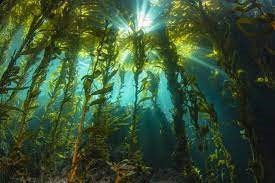Published on: February 1, 2023
Kelp forests
Kelp forests
Why in news? Kelp forests, an underwater ecosystems formed in shallow water by the dense growth of several different species known as kelps are declining due to climate change, showed a new study.
Highlights
- Kelp populations at equator ward-range edges are particularly vulnerable to climate change as these locations are undergoing warming at or beyond thermal tolerance thresholds
- This vegetation can sometimes persist at lower latitudes, aided by cool water upwelling or in deep-water refugia where they are protected by thermocline
- Ecklonia radiata, the dominant and most widely distributed Laminarian( Sea weed) kelp in the southern hemisphere, rapidly succumb due to warmer temperatures in spring and summer
About Kelp
- Kelps are large brown algae seaweeds that make up the order Laminariales.
- In great amount, kelp ash can be used in soap and glass production.
About Kelp forest
- Kelp forest are underwater areas with a high density of kelp, which covers a large part of the world’s coastlines and smaller areas of anchored kelp are called kelp beds.
- They are recognized as one of the most productive and dynamic ecosystems on Earth
- It occur worldwide throughout temperate and polar coastal oceans and kelp forests were also discovered in tropical waters near Ecuador.
- Classic studies in kelp forest ecology have largely focused on trophic interactions (the relationships between organisms and their food webs), particularly the understanding and top-down trophic processes.
- They sinks to the ocean floor and store the carbon where is it unlikely to be disturbed by human activity

